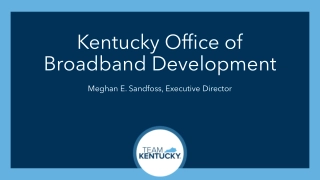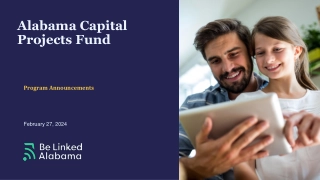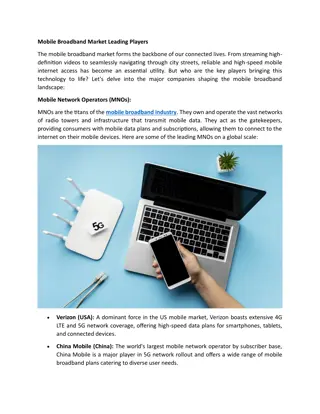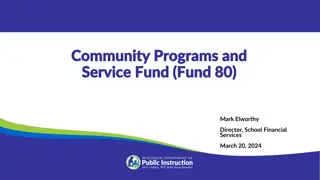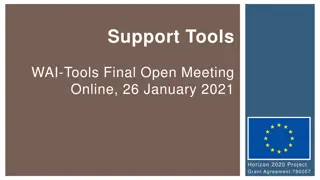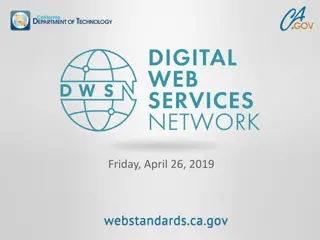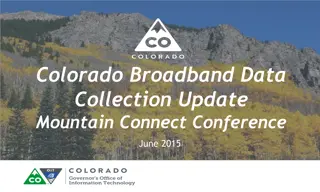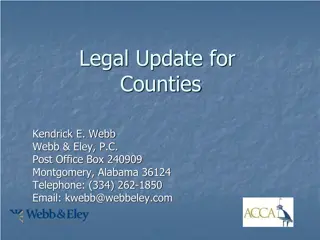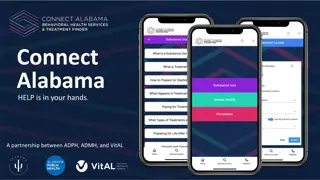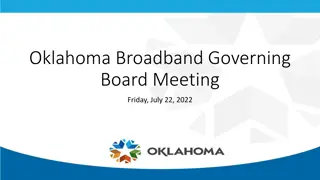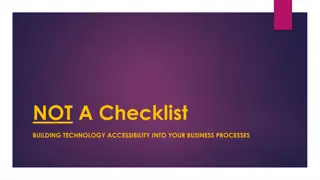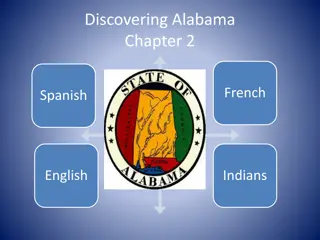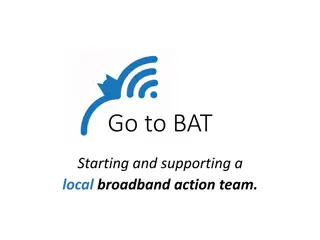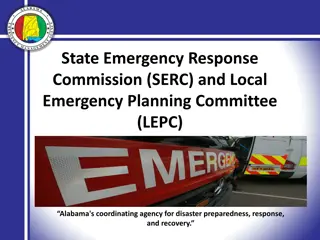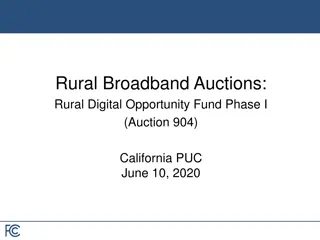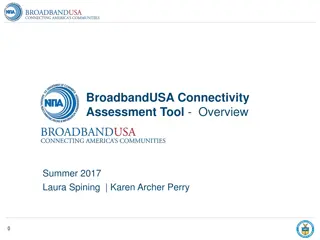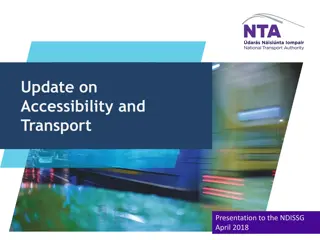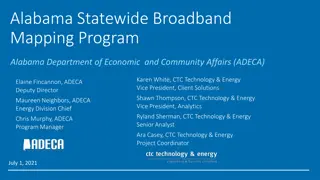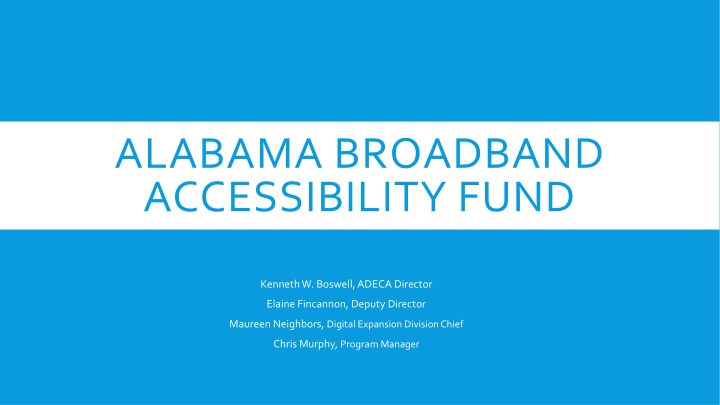
Alabama Broadband Accessibility Fund and Act Overview
Learn about the Alabama Broadband Accessibility Fund established under the Alabama Broadband Accessibility Act, including key definitions like end user, minimum service threshold, and rural area. Explore the Middle Mile Project and the history of amendments to the act signed by Governor Kay Ivey.
Download Presentation

Please find below an Image/Link to download the presentation.
The content on the website is provided AS IS for your information and personal use only. It may not be sold, licensed, or shared on other websites without obtaining consent from the author. If you encounter any issues during the download, it is possible that the publisher has removed the file from their server.
You are allowed to download the files provided on this website for personal or commercial use, subject to the condition that they are used lawfully. All files are the property of their respective owners.
The content on the website is provided AS IS for your information and personal use only. It may not be sold, licensed, or shared on other websites without obtaining consent from the author.
E N D
Presentation Transcript
ALABAMA BROADBAND ACCESSIBILITY FUND Kenneth W. Boswell, ADECA Director Elaine Fincannon, Deputy Director Maureen Neighbors, Digital Expansion Division Chief Chris Murphy, Program Manager
ALABAMA BROADBAND ACCESSIBILITY ACT HISTORY On March 28, 2018, Governor Kay Ivey, signed the Alabama Broadband Accessibility Act which established the Alabama Broadband Accessibility Fund. On May 30, 2019, Governor Ivey signed Act #2019-327 which provided numerous amendments to the original Act. On March 15, 2022, Governor Ivey signed Act #2022-138 which provided additional amendments to the original Act.
BROADBAND DEFINITIONS END USER: A residential, business, institutional, or government entity that uses broadband services for its own purposes and does not resell such broadband services to other entities. An internet service provider (ISP) and mobile wireless service provider are not an end user for the purposes of this act.
BROADBAND DEFINITIONS CONTINUED MINIMUM SERVICE THRESHOLD: A connection to the Internet that provides capacity for transmission at an average speed per customer of at least 100 megabits (100 Mbps) per second downstream and at least 20 megabits (20 Mbps) per second upstream (100 Mbps/20 Mbps). RURAL AREA: Any area within this state not included within the boundaries of any incorporated city or town having a population in excess of 25,000 inhabitants, according to the last federal census.
MIDDLE MILE PROJECT A broadband infrastructure project that does not provide broadband service to end users or end-user devices. Middle Mile Projects, where the applicant demonstrates that the project will connect other service providers eligible for grants under this section with broadband infrastructure further upstream in order to enable such providers to offer broadband service to end users; provided that eligible projects under this subdivision may include projects in (i) an unserved area or (ii) a rural area that does not meet the definition of an unserved area but otherwise meets the requirements of this section, for which the grant applicant demonstrates, by specific evidence, the need for greater broadband speeds, access, capacity, resiliency, or service which is not being offered by an existing service provider. (subdivision 2)
UNSERVED AREA Any rural area in which there is not at least one provider of terrestrial broadband service that is either: (1) offering a connection to the Internet meeting the minimum service threshold; or (2) is required, under the terms of another state or federal grant, to provide a connection to the internet at speeds meeting the minimum service threshold within the same or similar timeline of projects of similar complexity or scale awarded during each grant cycle. Projects to provide broadband service to a specific hospital, health care facility, public school, public safety, or economic development site in a rural area that does not meet the definition of an unserved area but otherwise meets the requirements of this section, for which the grant applicant demonstrates, by specific evidence, the need for greater broadband speeds, access, capacity, resiliency, or service which is not being offered by an existing service provider (subdivision 3).
ELIGIBILITY REQUIREMENTS Grants may be awarded to entities that are cooperatives, corporations, limited liability companies, partnerships, other private business entities, or units of government that provide broadband services. An entity is not eligible for a grant unless the entity has submitted, within the one-year period preceding the awarding of the grant, the entity s broadband service availability information to Alabama s broadband mapping program.
FUNDING The grant will be in the form of a reimbursement of eligible costs up to the award amount and/or percentage in the grant agreement. Reimbursement will be conditioned on the following: Project completion within two years of awarding the grant. Applicants who demonstrate project complexity may request more than two years to complete the project. Recipients who demonstrate that the project is progressing may request an extension for up to one year for project delays beyond the recipient s control. If a recipient fails to complete a project within the two-year deadline, or within the extended deadline, ADECA may revoke the grant in its entirety and rededicate funds to a new recipient. Note: Testing hardware, equipment, etc. may be an eligible expense. Please reach out to us to verify if testing expenses are eligible. The progressive completion, as measured on not more than a quarterly basis, of the approved project. Grants for projects not showing progress may be rescinded.
FUNDING CONTINUED Operational testing, when possible, to confirm the level of service proposed in the grant application. Such regulations shall not exceed in degree or differ in kind from testing and reporting requirements imposed on the grant recipient by the Federal Communications Commission, as adjusted for the service specifications in the ADECA grant agreement. Continued participation in Alabama s broadband mapping program throughout the entire project period. All projects will be scored based on the established rating criteria. Those eligible projects receiving the highest scores will be selected for funding. The number of projects funded will be determined by the funds available and the total amount of requests made. ADECA may request amended projects and/or offer reduced grant participation.
FUNDING CONTINUED Not less than 40 percent of funds appropriated for grants will be utilized in unincorporated areas of the state. Grants issued under subdivisions 2 and 3 shall not exceed 40 percent of the total funds appropriated from grants on an annual basis. Individual grant awards will be for projects in unserved areas that will be capable of transmitting broadband signals at or above 100 megabits per second of download speed and 100 megabits per second of upload speed (100 Mbps/100 Mbps). Awards may not exceed the lesser of 80 percent of the project cost, or $5,000,000. Any award of state funds under this act, when combined with other forms of state or federal support or assistance dedicated to the project, other than interest-bearing loans, may not exceed 90 percent (90%) of the total project costs.
PRIORITY AREAS Seeks to leverage grant funds through private investment and extension of existing infrastructure. Serves locations with demonstrated community support, including, but not limited to, documented support from local government. Demonstrates the operator s technical and managerial capabilities to complete the project within two years of the grant. Applicants who demonstrate project complexity may request more than two years to complete the project as part of the application. If an increased time for completion is approved by ADECA, the increased time frame will be included in the grant agreement. Demonstrates the applicants necessary financial resources to sustain service to the project area and provide adequate project financing.
PRIORITY AREAS CONTINUED Is the most cost effective and technically efficient in that they propose to serve the highest number of unserved homes, businesses and community anchor points for the least grant fund cost and best level of service, emphasizing projects including the highest broadband speeds (at least 100 Mbps/100 Mbps). Provide material broadband enhancement to hospitals, clinics, and other medical facilities located in rural areas. Support local libraries in this state for the purpose of assisting the libraries in offering digital literacy training pursuant to state library and archive guidelines. Provide support for the deployment of infrastructure to be owned and operated exclusively by internet service providers serving subscribers in Alabama for at least three years or organizations incorporated, headquartered, or with a principal place of business in Alabama.
ADDITIONAL CONSIDERATIONS Applicants applying for service areas where the existing connection to the internet provides capacity for transmission at an average speed per customer of less than 25 megabits (25 Mbps) per second downstream and three megabits (3 Mbps) per second upstream (25 Mbps/3 Mbps). Applicants who plan to use vendors and subcontractors that have been certified by the Office of Minority Business Enterprise or that are Disadvantaged Business Enterprises. If an applicant chooses to claim consideration under this criterion, a quarterly report documenting activities will be required. Vendor and subcontractor self-certification of Minority, Female Owned, or Disadvantaged Business Enterprise status will not be accepted.
ADDITIONAL CONSIDERATIONS CONTINUED The average pole attachment rates that a grant applicant charges to an unaffiliated entity, provided that this subdivision (5) shall not apply to a utility as defined under Section 37-4-1 (7)a. Applicants who have committed to improving the adoption rate of broadband services by offering programs to households that meet guidelines established by ADECA or the funding source, including, but not limited to, special service rates, internet-enabled devices the meet the needs of the user, and digital skills training. Applicants that provide documentation that it has been certified by the ADECA Office of Minority Business Enterprise or otherwise as a Disadvantaged Business Enterprise. Documentation of certification does not include self-certification as provided in SAM.gov.
LETTER OF INTENT Applicants are required to provide a letter of intent to submit an application by 12:00 PM (noon), CST, on April 29, 2022. The letter of intent shall include the applicant s contact information and the proposed project area in either a .kmz, .kml, or shapefile format. The applicant s shapefile must use a polygon format to represent the proposed project area. Other formats such as lines or points will not be accepted. The applicant must also ensure that the polygon format covers the rooftop locations of all addresses in the proposed project area. The letters of intent will be posted on the ADECA website and publicly available to promote coordination between applicants regarding overlapping service areas. Applicants and existing ISPs are strongly encouraged to contact applicants regarding their letters of intent within 30 days of the posting of the letters on the ADECA website to ensure compliance with the grant program deadline.
LETTER OF INTENT CONTINUED If an applicant intends to apply for funds under subdivisions 2 and 3, the applicant shall include that information in the letter of intent. Note: Minor changes to the project area between the time the letter of intent is submitted, and the final application are allowed; however, applicants are instructed to clearly identify any changes in the final application map and narrative.
2022 PROGRAM TIMELINE Open Application Period: March 31, 2022 June 28, 2022 Letters of Intent Due Date: April 29, 2022 @ 12:00 PM (Noon), CST Application Due Date: June 28, 2022 @ 12:00 PM (Noon), CST
CONTACT INFORMATION Email Address: Street Address: Mailing Address: broadband.fund@adeca.alabama.gov 401 Adams Avenue, Suite 592 Montgomery, Alabama 36104-4325 Post Office Box 5690 Montgomery, Alabama 36103-5690 Website: http://adeca.alabama.gov/broadband Please sign up for our email notifications!

